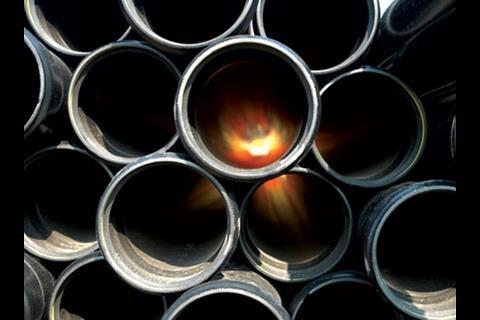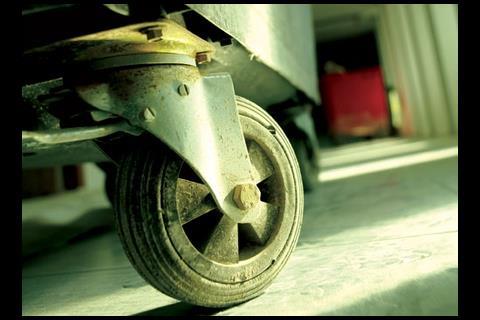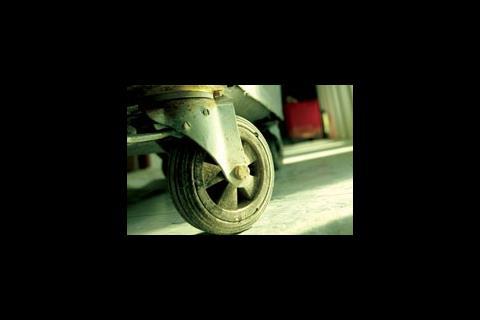Site waste has never been the most glamorous end of the sustainability agenda. But, with a stringent regulation and a sharp rise in landfill tax being introduced this month, you ignore it at your peril. Dr David Moon of WRAP and Adam Mactavish of Cyril Sweett offer advice on how best to control the beast
This month, a new regulation in England requires construction pro jects over £300,000 in value to implement a Site Waste Management Plan (SWMP). This is not only aimed at reducing fly tipping, but also requires people to forecast and measure their construction waste on larger projects.
The SWMP regulation, together with increases in landfill tax, new government targets and the increasing number of major clients setting specific performance requirements for resource efficiency, is set to dramatically increase the profile of waste in the drive towards more sustainable construction.
So, are all these initiatives just another cost burden on the sector, or do better materials and waste management make commercial as well as environmental sense?
What does the new regulation demand?
• The client and principal contractor are jointly responsible for preparing the SWMP prior to work starting on site
• They must ensure that all waste is dealt with in accordance with their duty of care, and seek to prevent illegal disposal
• For projects over £500,000, the SWMP must:
- forecast the quantities and types of waste
- identify actions taken to minimise waste and to manage different types of waste
- record waste movements
- record the actual quantities and types of waste going to different destinations (reuse, recycling, other recovery, landfill – on and off site)
- compare forecast against actual waste
- estimate cost savings from implementing the SWMP
• The principal contractor must ensure, so far as is reasonably practical, that waste produced during construction is reused, recycled or recovered
• Workers must be trained to implement waste management measures
• It will be an offence to intentionally obstruct any person executing the regulations, for example by failing to produce a SWMP or provide information, or by giving misleading or false information.
The zero-waste agenda
The SWMP regulation is only one of a series of policy initiatives placing increasing emphasis on the effective minimisation and management of construction wastes. Other measures include:
• A sharp increase this month in landfill tax, by 25% on inert waste and 33% on non-inert waste such as packaging and timber – with the latter doubling to £48 per tonne by 2010
• The need to adopt an SWMP as a minimum element in Code for Sustainable Homes assessments (with additional credits available for good practice). From May, a rating against the code becomes mandatory for new homes
• The government’s Strategy for Sustainable Construction. This will be launched in June and is expected to include targets of halving waste to landfill by 2012 and achieving zero waste to landfill by 2020.
The government has indicated that it is looking for sector commitments and voluntary action to help deliver the headline targets in the Strategy for Sustainable Construction. This recognises that halving construction waste to landfill will depend on clients and contractors pushing for good practice – in other words, going “beyond compliance”.
Major industry bodies such as the British Property Federation and Home Builders Federation are considering their response. A number of key construction clients and contractors are already voluntarily committing to improve their resource efficiency. For example, Bovis has committed to a 70% reduction in waste to landfill by 2010 relative to a 2007 baseline, and Wates is targeting zero non-hazardous waste to landfill. Other key construction clients setting waste and resource management targets include: Asda, Barratt Developments, Berkeley Group, Land Securities, Marks & Spencer, Persimmon and Sainsbury’s.
This fits with the broader proposal of the Strategic Forum to extend the Olympic Construction Commitments across the sector. For sustainability, the Olympic commitments state that: “Targets, including the business case, will be set within all contracts, and performance will be monitored and appraised regularly.”
Costs and benefits
It is inevitable that implementing SWMPs will result in some project costs. The key questions are: what is the scale of the cost, and what are the business benefits of better materials and waste management?
Defra has recently published cost benefit analysis of the impact of SWMPs. For a £1.6m new-build project, the estimated costs approach £3,000. These comprise:
• £300-400 for SWMP preparation
• £400 for training (including managers’ time, but excluding workers’ time)
The test projects found that focusing on the financial costs of waste was a real drive for action.
• £1,900-2,100 for monitoring, updating and auditing.
However, the quoted benefits from waste reduction and recovery are five times higher than the SWMP implementation cost for a domestic new-build project of this size. These are derived from:
• A £5,000 reduction in the costs of disposing of segregated wastes
• An £8,000 saving in the value of materials wasted
• A £2,400 saving in sending less waste off site.
It is worth adding that these figures are estimated before the increases in landfill tax. Adjusting for these increases would add a further £500 to the cost of waste disposal in 2008, rising to more than £1,500 in 2010.
Therefore, on the face of it, bare compliance with the SWMP regulation, which goes no further than forecasting and measuring waste, will incur a net cost. To achieve a financial benefit from the SWMP process, it is essential for a project team to go beyond compliance.
When successfully implemented, the savings from waste planning can be significant. For example, Simons Construction has measured savings of £28 per tonne of waste from on-site segregation; this saving is forecast to double as landfill tax increases.
The savings from waste reduction can be even greater, because not only are disposal costs avoided, but fewer materials need to be purchased in the first place. To demonstrate this, WRAP has combined cost plan data for a range of building types with contractor information on baseline and good practice wastage rates for different components. By moving from baseline to good practice, savings in the value of materials purchased could amount to about 1% of construction value – ranging from 1.8% for housing to 0.3% for retail fit-out in the eight case studies examined. The table overleaf illustrates this analysis for an apartment building, where good practice could save materials worth 0.9% of total construction cost relative to baseline industry practice.
Add to this the environmental benefits of resource efficiency, the reduced risk of prosecution and the associated reputational damage, and the argument for adopting SWMPs becomes persuasive.
The role of the Net Waste tool
The Net Waste tool helps SWMP compliance by generating forecasts of quantities and types of waste and by proposing actions by which these can be minimised and managed. The tool also records actual waste levels, which can then be compared to forecasts, helping to improve forecasting and site practices. By providing data on both the value of wasted materials and the cost of waste disposal the tool is a powerful source of information to help reduce project costs.
The Net Waste tool has been designed as a series of simple web pages on which the user enters information on their project and the materials they are intending to use in order to carry out analysis on both waste management and recycled content. Because the new tool uses the same core dataset as WRAP’s existing recycled content toolkit, it is only necessary to enter project information once to conduct both analyses.
Using benchmark data on baseline and good practice waste rates for more than 6,000 construction components, the tool not only estimates how much waste is likely to be generated in any given month of a project, but also identifies the key priorities for reducing waste – that is, those components where there is the greatest potential to reduce the overall value or mass of wasted materials by adopting good practices. For each of the priority opportunities, the tool will suggest the most relevant waste reduction actions.
Having targeted the key sources of construction waste, the tool then helps in the development of a suitable waste segregation strategy. Using information on the cost of disposing of different waste streams, the tool identifies those waste streams that will offer the greatest reduction in disposal cost if separated out from the mixed waste stream. All of this information is presented on a monthly basis so the user can plan which waste containers to keep on site at any time.
The last step in the waste analysis is to determine the destination of each of the waste streams segregated on site. By determining the likely destination of each waste and, if known, the actual performance of the waste handler in recovering materials from the waste stream, the tool estimates the likely amount of waste going to landfill and that which will be recovered.
Having completed the analysis of waste and its management, the tool then uses the same core data to identify opportunities to use recycled materials.
The Net Waste tool can be used to generate scheme-wide results and can even be used to report on industry or sector performance, by reporting the aggregated results for a number of defined projects and/or schemes.
Analysis in practice
WRAP has conducted a number of test projects to assess the practicality and value of taking a more analytical approach to waste management. The contractors involved included Balfour Beatty, Bovis, Carillion, Crest Nicholson, Skanska, Wates and Willmott Dixon. The results from these studies are enlightening, both in the nature of the wastes identified and in the power of financial information on the cost of waste to spur changes in behaviour. Seven projects were assessed valued between £32,000 and £14m. The value of materials wasted ranged from 1.5% to over 6% of total materials costs on the project, with £420,000 of materials wasted on one site.
All of those involved in the test projects found the focus on the financial costs of waste a real drive for action. Other benefits include the ability to negotiate better rates for waste disposal with waste contractors. By gathering better information on the nature of the material being collected it is possible to assess the real costs and value of the waste, enabling a closer working relationship and lower disposal costs.
It may not be as glamorous as building the first zero-carbon home, but effective waste management is an area of sustainable construction where there is money to be made from doing the right thing. It is also one of those issues where doing the bare minimum costs a lot more than doing it properly, because it is only by doing it properly that the benefits are achieved to outweigh the costs.
Available support
Stage: Setting requirements
WRAP publishes comprehensive guidance () on setting requirements for waste management and recycled content in construction. This includes exemplar wording that can be used for policy statements, project briefs, contract clauses, and so on.
Stage: Forecasting and targeting
Examples include WRAP’s Net Waste tool () and National Green Specification’s WasteCost (). WasteCost uses basic building dimensions to estimate quantities of waste, while the web-based Net Waste tool uses cost plan data to get a more accurate forecast, identify the most effective waste reduction and recovery options and provide guidance on their implementation.
Stage: Setting up the site waste management plan
WRAP has just launched its SWMP template for general construction, housing and civil engineering projects, which has been developed with Halcrow, Costain, C4S, the NHBC Foundation and BRE (available from ). The template comprises a series of 14 steps, which follow the construction lifecycle from pre-design to project completion and review, and is supported by a range of guidance.
The template will enable contractors to develop key performance indicators for waste and materials, and monitor performance throughout the project. Importantly, the template can be used to demonstrate good and best practice performance beyond simple standard compliance with the regulations. The template is spreadsheet-based, and offers the flexibility for use either in its entirety or for relevant elements to be incorporated into templates or systems that a company may already have in place.
Stage: Waste data capture
The best known system for capturing waste data is BRE’s SMARTWaste suite of tools (). These integrate on-site waste measurement with SWMP reporting and benchmarking. This system also ties into a web-based tool designed to generate summary data on waste totals, suitable for use as appendices to an SWMP ().
Envirowise provides a SWMP Builder spreadsheet tool, aimed particularly at smaller builders, to help organise information on types and quantities of waste arising from a project ().
The tool is supported by an animated click-through induction.
Other systems include a spreadsheet and web-based tool from Upstream (), which captures data for waste containers on quantity, composition and destination. It then generates KPIs and management information.
Alternatively, a number of contractors use bespoke spreadsheet templates to transfer data from waste management contractors or log data from waste transfer notes.
Stage: Reviewing and reporting
WRAP’s Net Waste tool and SWMP template both enable the comparison of actual project performance with the target at the outset of the project. The Net Waste tool also enables a user to review the results of all of the projects in their portfolio (or, for example, just those completed in the last 12 months).
Implementing good practice
Effective waste and resources management must start during the design stage of a project, when waste can be avoided at source. The crucial first step is therefore for construction clients to take the lead and set clear performance requirements for their design teams, even during the earlier stages of design.
However, it must be a targeted process. There is no point in attempting to generically “design out waste” on a project - there are simply too many components and processes to consider. Effective waste forecasting is therefore a key starting point of any strategy.
Once waste has been forecasted and strategies have been determined to manage it effectively, the next step is to embed these requirements within project processes in the form of contract clauses and within the SWMP. Ultimately, processes are needed to accurately record waste and its fate (landfill, recycling facility, and so on) so that actual practice can be reported and compared to the original forecast:
See attached graphic 'Waste disposal practices'.
Downloads
Cost savings from lower waste rates
Other, Size 0 kbWaste disposal practices
Other, Size 0 kb
Regulations April 2008
- 1
- 2
- 3
- 4
- 5
- 6
- 7
- 8
- 9
- 10
- 11
- 12
- 13
- 14
- 15
- 16
- 17
- 18
 Currently reading
Currently readingWaste and how to tame it





































No comments yet